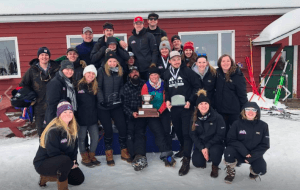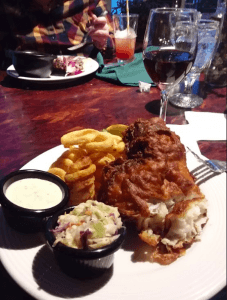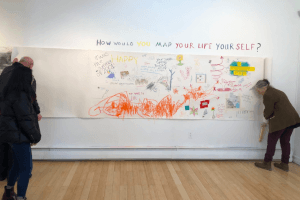
Mar 15, 2019 | Sports |
By Libby Shanahan Contributing Writer

The Alpine Team recently came first in the Reynolds Division and won the Ricker Cup (Photo courtesy of UMF Snow Sports Facebook)
The day starts at 5:30 a.m. in the dead black of a winter morning, standing atop a race course and looking down upon a snow-covered incline fit only for expert skiers — this is what the women and men athletes of the UMF Alpine Team live for. What some do not understand about competitive ski racing is the amount of dedication and resilience one must posses in order to push yourself to be a collegiate level athlete.
The season begins far before winter. Athletes must complete a preseason training regimen, which starts in the very early weeks of school when students return. A combination of different dry-land exercises such as weight training, agility and various athletic testing is just a glimpse of what these athletes put themselves through in order to perform at their level. Returning athletes are given a packet of weekly exercises which they are expected to complete each week throughout the summer. In short, the athletes undergo a yearlong preparation for a three month season.
Erin Buckland, junior, general studies major and student-assistant alpine coach describes the vigor she observes in her peers. “There certainly aren’t a lot of people that can say that this is what I do,” she paused, “it is almost as if athleticism comes second to dedication.”
Buckland, a Farmington native and Carrabassett Valley Academy alum (CVA; a competitive snow sports high school), jumped at the opportunity to work with head coach, Andrew “Andy” Willihan ‘06. “Willihan coached me throughout my high school career, and was actually one of my dorm parents at CVA,” she said. “I raced with UMF for a couple years before transitioning into my student-assistant coaching position.” Buckland commented on what it was like working with Coach Willihan. “Out of all of the sports teams that I have been on, and the different coaches that I have had, Willihan has always been my favorite.”
Coach Willihan began his post as head alpine coach and outdoor recreation coordinator in 2016. Along with years of experience in coaching ski racers, Coach Willihan has a way of connecting with his athletes. “Andy continuously supports everyone on his team, whether it be on the hill or in the community,” said Alicia Gaiero, junior and environmental policy and planning major. Gaiero recounted one of the first instances that she met Coach Willihan and was introduced to the team’s dynamic, “I had never touched a race gate before in my entire life, but Andy really embraced the fact that I was new to the competitive aspect of the sport in a way that boosted my confidence.”
Brianna Marquis, sophomore and psychology major worked with Coach Willihan in years prior while attending Carrabassett Valley Academy, “Andy has recruited me twice, and he has become the person that I go to if I need to talk to about something serious, or really just someone that will hear me out.” Upon learning that UMF offered a varsity level alpine team, and that Andy would be heading the program, Marquis’s decision was solidified. “Coming from a competitive background, I was interested in something that would continue to challenge me athletically.”
Since Coach Willihan’s arrival, the program has seen many advancements. The Ricker Cup is awarded to the team that places first out of the handful of teams within the Reynolds Division, and this year both the women and mens team landed at the top of the podium. “Three or four years ago this team was last in the division, and now to come in first… we’re only going to go up from here,” said Marquis.
The team is very young, and only two athletes will be graduating this year. “We are still growing, and are always recruiting!” said Marquis. Gaiero encourages anyone who is interested in learning more about how to join to reach out, “we are a super inclusive team, and welcome any skill level.”
Mar 15, 2019 | Feature |
By Allison Jarvis Contributing Writer
The Otaku Club was founded five years ago to explore Japanese culture and for students to watch anime together. Rowan Burns, the current president of the Otaku club, and fourth year Early Childhood Education and Psychology major, describes some of the events that are arranged for the club’s members.
“We go to two conventions every year,” said Burns. “We host a lot of events. We do a tea party now, ‘Host Club’ style. We’re planning that right now.”
Every semester, the club arranges to take twelve members, including E-board, to a different convention. They travel to Another Anime Convention (AAC) in the fall and Anime Boston in the spring. At conventions, you will see people dressed in cosplay of their favorite anime, as well as games and panels where guest speakers like creators or voice actors are invited to speak and answer questions.
“I enjoy walking around and meeting new people and seeing the cosplays,” said Burns. “A lot of people, if you’re in cosplay, will ask for your picture. A lot of professional photographers will go to these events to do sessions.” Members of the club are encouraged to go dressed in cosplays if they choose to, and the officers always make sure everyone has time to get into their cosplays before going into the convention.
Besides going on trips to conventions, Otaku club now has a new event where they host a tea party in the landing themed around the popular anime “Ouran High School Host Club.” The officers of the club dress in uniforms and the landing is decorated with table cloths and tea lights. Tea and coffee and snacks are served and the “Host Club” anime is screened on the projector. “We tested it last year and it was a big hit,” said Burns. “People just came in and they watched anime and had snacks and talked and hung out and it was so much fun.” The tea party is now being hosted once a year every spring semester, to try and line up with the Japanese cherry blossom season.
When the club isn’t going to conventions or hosting tea parties, they spend time together and watch anime. Once a month they have a “voting day” when members will shout out their favorite animes, and then the club will collectively vote on the lineup of showings for the month. “It’s very much club member participation based in that sense,” said Burns. “We don’t just have officers picking stuff, we’re really asking people what they want to watch.”
Attendees are always exposed to something new and different. The shows range from light-hearted to heartbreaking. “We’ve had [shows] where people cried in club ‘cause they’re so sad!” said Burns. Content warnings are always given before a screening, should there be any heavy themes that might be hard to handle, so that the Otaku club can be a safe and inclusive place.
While attending Otaku club meetings is a fun way to pass the time and of being exposed to and learning more about Japanese culture, the club is also a place to spend time with like-minded friends. “I like being in the room with so many people with shared interests, but in a more relaxed way,” said Benjamin Hayes, sophomore Special Education major and club member. “I’ve definitely gotten a lot closer with other members… who I otherwise probably wouldn’t have connected with.”
“Anime’s such a weird niche interest, where you either like it or you hate it,” said Burns. “And there are so many people who just adamantly hate it. And it’s hard to find those spaces where people aren’t thinking you’re weird for enjoying it.”
The Otaku club meets in Thomas Auditorium every Friday from 4-6PM. If a student should have any questions, they can contact Rowan Burns at nikole.burns@maine.edu
Mar 15, 2019 | News |
By Kara Doane Contributing Writer
Sophomore students Lindsey White and Julianne Petrie recently found out that they will be walking with the class of 2020.
White and Petrie entered UMF in the fall of 2017 and expected to graduate in the spring of 2021. Carol Lee had told White and Petrie that it was a possibility to graduate early during their freshman year on campus. “During pre-registration this semester Patti Bailie told me I can walk at graduation in spring 2020,” said White. “It honestly blew my mind.” While Petrie has a different advisor, herself and White went to the same high school and took all of the same classes.
Graduating early was never the intention for White. In high school she took many AP courses, advanced classes, and college classes online. “I took 15 hours of college classes in high school online through University of Maine at Fort Kent (UMFK),” said White. “I took Advanced Placement Literature and Language but failed the AP test. I also took advanced math and science classes.”
White and Petrie’s intention of taking AP classes was to save some money for when they got into college. As they both came into UMF with a full semester’s worth of transfer credits, their goal had been met. They managed to save on a whole semester’s tuition.
Graduating early could be the new trend as, “high schools are offering more college courses/AP classes at a discounted rate,” said Petrie. “I think I only paid about $80 for each college class in high school, compared to $1,200 for each class when I’m actually in college.”
White suggests to anybody wanting to graduate college early, “If your high school offers college classes, take them! It may be a lot of work but it’s so worth it.” For those who didn’t have the opportunity to take college classes in high school, Petrie suggests, “take May terms and summer classes. Online classes aren’t too bad if you can motivate yourself to do the work without going to class every day.”
White and Petrie had both taken ANT101 (Introduction to Anthropology) in May 2018 and are planning on taking ECH402 (Diverse Programming in Early Childhood) in Summer 2019.
White is not ready to graduate next year, saying, “God no, be an adult? No, I’m mainly doing it to save money.” White is nervous about entering the working world post-college as she says, “What if my job is far away and I have to get a real apartment or live alone? I’m ready to be a teacher but I don’t want to be a full adult.”
White will turn 21 in March and will walk in May, “So I’ll still be a baby. Being younger when entering the workforce, it could be a possibility that I could not be taken as seriously by employers/coworkers,” said White. The only positive that she mentioned was saving so much money.
Petrie is ready to graduate but shares White’s fears. “By graduating early, I’m nervous about being super stressed all the time and not being able to relax and have fun when I need to.”
White and Petrie have had a good experience at UMF. “College has been fun. I definitely struggled this past fall semester but having a good support system at home helped me stay on track,” said White. “I am not graduating with my friends I entered college with, but I do have tons of friends in the 2020 graduating class.”

Mar 15, 2019 | News |
By Jeremy Austin and Eryn Finnegan Staff Reporter and President

The Fish N’ Chips had crispy, flaky skin, while retaining flavorful juices inside. (Photo by Jeremy Austin)
The Flyer’s dam good food recently visited Calzolaio Pasta Company, a higher-end restaurant located in a tall, dark red building lined with fairy lights and surrounded by a river cutting the road off from the parking lot. A fifteen minute drive from the UMF campus in Wilton, ME, Calzolaio is a place with an expansive menu and creative flavor combos, but runs high price-wise, so be ready to splurge.

Mar 15, 2019 | News |
By Emma Pierce Contributing Writer

“How Would You Map Your Life Yourself?” began as a blank scroll that viewers could add onto themselves. (Photo by Keely McConomy)
To start off the spring semester, the UMF Art Gallery has been hosting a collection of interactive works by Colby College alumni Maggie Libby entitled Across References since Feb. 7. The installation is staying until March 14.
Through her art Libby encourages the viewer to ask “provacative questions” about womens’ roles in history and how Maine’s geology may change over time.
“I have this duality of having a rich and wild New York art experience and then coming back to Maine with this isolation and poverty,” Libby said after explaining her time at the New York Studio School. “So this is why I want to think about, ‘What’s the real Maine? What’s the real Maine experience?’”
Libby hosted an “art talk” in the UMF Art Gallery on March 1. Art talks are lectures where the artist presents their art and the methods behind it in hopes of listeners gaining knowledge on different forms of art.
Though lectures can be influential, Libby invited the audience to engage in ways other than listening right away. “So much of my work is about trying to create a dialogue and interaction between object and viewer,” Libby said, “so I would love to make this a nontraditional [talk] and instead have it be a conversation.”
Libby presented strength to her audience of 20 in her opinions about womens’ roles in the art industry, the status of Maine’s environment, and her stance on her art. “Art is my medium,” she says. “So art is my voice.”
One of Libby’s pieces features the history of the Sandy River and its surrounding area, which she researched extensively. Libby mapped the Sandy River as a way to leads the viewer from her charcoal drawing of Saddleback Mountain to just before Farmington, mapping the Wabanoki tribe and other geologic features along the way.
Visitors have interacted similarly to another piece boldly titled, “HOW WOULD YOU MAP YOUR LIFE YOURSELF?” On the installation’s opening day, the piece was a blank scroll of paper spread across the gallery wall, but at Libby’s art talk the artist and participants helped Libby unroll the rest of the scroll to make room for more viewers’ art to be made.
Meadhdh Carroll, Creative Writing and English major, was struck by the significance of the concept of mapping a life. Carroll says Libby is trying to inspire change in her viewers. “It just seems like [she’s trying to ask], ‘what are you passionate about?’ or ‘what is something that you would fight for in your life?’” Carroll says.
Visitors have used materials, such as charcoal, maps and markers, provided by the gallery and Libby to become a part of Libby’s art, smearing words stenciled in charcoal and drew pictures on each of the pieces.
The gallery’s newest installation doesn’t only encourage those who draw. Libby has also made a box, some containing writing and others containing objects of different textures. “The other thing I love as a Maine resident is I love to look at the birds,” Libby says with a smile as she introduced her box containing housing insulation and birds, developing on her question of “What’s the real Maine experience?”
Libby’s installation also features portraits of women who have indirectly and directly influenced her life. Her passion for including women as a significant topic in her art was greatly influenced by the work she does as curator of the Colby College Archives’ visual resources. “In my life at the Archives, I realized that. . .women’s history is either nonexistent, lost, forgotten, or overlooked,” Libby says.
One of her pieces features five women who formed the first social protest at Colby College, focusing on the segregation of the school by biological sex. Libby produced it with a material that causes them to disappear, reflecting on what happens when we don’t speak up for what we want.
Carroll felt the importance of the inclusion of women in art. “When I look at the portraits of the women,” Carroll said, “I think of the impact that women have had on history. It’s very inspiring because. . .you’re looking at these portraits of these women that have changed so many people’s lives and it kind of seems like she’s trying to get that out of [the viewer].”
At the end of her art talk, Libby gave those who attended an assignment: “Think about how you can map or articulate or draw the boundaries of your life,” she says. After the art talk ended, the participants mapped their lives and chatted with Libby about art and its prescence in today’s world over coffee and snacks.
In a time when the campus is divided on issues that plague our university and our world, it is important that we find a way to express the anger, frustration, and need for change in ways that are not filled with malice intent. Across References came at just the right time.



